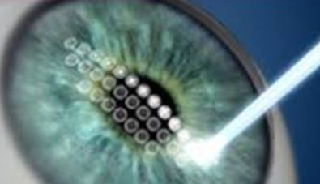
What is PRK?
PRK stands for Photo-Refractive Keratoplasty, a cousin of LASIK and a highly successful laser procedure that can reduce and usually eliminate your need for glasses or contact lenses in just minutes. The difference between PRK and LASIK is that PRK delivers vision-correcting laser light right to the front surface of the cornea, the clear front window of the eye. By contrast, LASIK involves creation of a thin flap of corneal tissue which is hinged out of the way. Vision-correcting laser light is applied to the tissue underlying the flap and the flap is then lowered back into its original position. At One to One LASIK San Diego, we perform PRK using the Wavelight Allegretto excimer laser which offers wavefront-optimized and topography-linked technologies for the most highly customized PRK treatment available anywhere. The Wavelight Allegretto is the only laser system that specifically delivers treatment in a way that preserves the most normal curvature characteristics of the cornea. This greatly reduces the risk of unwanted side effects such as poor night vision, glare, and halos.
Who can be helped by PRK laser vision correction at One to One LASIK San Diego?
Both LASIK and PRK can be used to treat nearsightedness, farsightedness, astigmatism, and the age-related need for reading glasses known as presbyopia. PRK is often a good option when a patient’s cornea is too thin to perform LASIK safely. PRK may also be recommended for patients wanting a touch-up or enhancement of their vision result several years after LASIK. Doing PRK in this situation makes it unnecessary to try to lift the patient’s original LASIK flap or to make a new flap.
Who will be doing my PRK procedure at One to One LASIK San Diego.
Laser vision correction expert, Dr. Angelique Pillar has performed thousands of vision-correcting procedures including LASIK, PRK, cataract surgery, corneal transplant surgery and implantable contact lens surgery and has special expertise in the newest technological advances. Raised in the Bay Area, she is a graduate of Yale University and Harvard Medical School and completed her Ophthalmology training at the University of Maryland in Baltimore. She pursued advanced fellowship training in corneal and refractive surgery at the world famous Cleveland Clinic and then then returned to Baltimore, joining a prestigious eye surgery private practice while also serving as Clinical Assistant Professor at the University of Maryland.
Dr. Pillar has performed thousands of cataract, cornea, and laser vision correction procedures, and has special expertise in the newest technological advances. She performs laser-assisted cataract surgery, complex cataract surgery, LASIK, PRK, crosslinking, Intacs, implantable contact lens surgery (Visian ICL) for high nearsightedness, lens fixation and lens exchange surgeries. She has done a high volume of corneal transplants including DALK, DSEK, DMEK, INTACS, and Boston keratoprostheses (KPro).
Beyond her unique surgical skills, what sets Dr. Pillar apart is her award-winning teaching ability. She takes great pride in listening to her patients carefully and educating them thoroughly about their eye problems and treatment choices – a perfect fit with this practice’s longstanding “One-to-One” philosophy of highly personalized and compassionate care.

How does PRK work?
PRK laser vision correction works by using computer-controlled, painless laser light to change the shape of the cornea – the clear front window of the eye. The eye works much like a camera. Light enters the eye through the cornea and the cornea helps focus that light onto the back of the eye. If that cornea has just the right shape, the light will fall in focus precisely on the retina which works like the film in a camera – and the images you are looking at will be in crisp focus.
If you are nearsighted, your cornea is too curved to focus light properly on the retina, and PRK can be used to flatten the cornea. If you are farsighted, your cornea is too flat to focus light properly and PRK can be used to steepen the cornea. If you have astigmatism, the cornea is shaped more like a football than a basketball which causes vision to be distorted. PRK can be used to make the central cornea more round, reducing or eliminating the visual distortion. If you need glasses to read (called presbyopia), the reading muscle in your eye has become too weak to see up close. PRK can change the shape of the cornea of an eye to improve its ability to focus up close.
What is it like to go through PRK? Does it hurt?
The PRK procedure itself does not hurt at all. Ittakes only minutes to perform and is done in an office-like outpatient laser center, not an operating room. During the procedure, your eyes will be numbed with a drop of anesthetic so you won’t feel any pain. You’ll usually be given a small dose of a sedative such as Xanax or Valium in advance to help relax you and take the edge off. The anesthetic drops usually last about 20 minutes. After that, most patients do experience mild to moderate eye discomfort for the first one to three days. PRK is different from LASIK in that respect, as LASIK is rarely if ever associated with significant post-operative discomfort. However, the discomfort associated with PRK is generally easy to control with a combination of pain pills, medicated eyedrops, and a special contact lens called a “bandage contact lens” which we place on the eye at the end of the procedure and which stays on the eye day and night for the first 3 days or so and is then removed in our office. The bandage contact lens is clear so you can see through it, though it is normal for your vision to be blurred for the first several days after PRK. This is another way in which PRK differs from LASIK. LASIK patient often see very clearly the day after surgery. PRK requires a little more patience for return of vision. Most patients have pretty good vision by the third or fourth day after PRK, but it may not be possible to drive, work, or study for those first few days, so you should plan your schedule accordingly. Most patients enjoy good vision within the first week after PRK, though the vision generally continues to improve for anywhere between three weeks and three months after the procedure.
Does One to One LASIK charge extra for PRK?
No. At One to One LASIK, we believe every patient deserves only the best technology available to treat their particular vision problem. The cost for LASIK and PRK are the same.
How soon can I come in to One to One LASIK San Diego for a complimentary laser vision correction consultation?
We can almost always offer you a complimentary LASIK or PRK consultation with Dr. Pillar on the same day you call or the next day. We can also schedule farther in advance if you prefer. Simply call 858.273.0200 right now and say “I’d like to schedule a free laser vision correction consultation.
